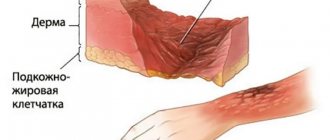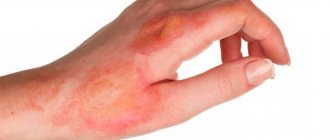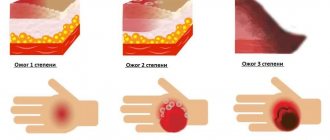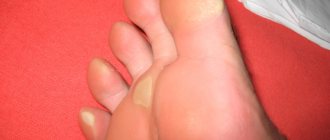Eye burns are not that uncommon , especially when it comes to interactions with acids (boric, salicylic, sulfuric, etc.). And each of them causes discomfort and pain .
But what to do if acid gets into your eye? How to provide first aid to an adult and a child at home?
In what case should you seek help and what consequences could happen if you do not take any action to save your eye?
How is treatment carried out after first aid and is it possible to do without surgery? We'll figure it out in the article.
Acid gets into the eye - symptoms
Keep in mind! Depending on what kind of acid gets into the eye, the victim will experience certain symptoms.
Here are the common types of acids that can inadvertently get on the mucous membrane of the eyeball:
- Salicylic acid. Causes a feeling of intense burning (sometimes with the inability to open the eye) and cutting pain, as if soap or shampoo got in while washing. However, if you immediately take measures to eliminate the irritating substance, the pain will soon go away and the eye will gradually recover.
- Boric acid. In the first seconds after acid enters the mucous membrane, symptoms such as severe pain, lacrimation, and photophobia are observed. Swelling and redness of the conjunctiva, a sensation of a foreign body in the eye, the appearance of blisters on the skin around the eyes, and slight blurred vision appear. And if the victim is not provided with timely assistance, then he can completely lose his vision (since not only the mucous membrane, but also the cornea will be damaged).
- Battery acid. Depending on the severity of the burn, different symptoms of injury occur. So, with a first-degree burn, pain and slight blurred vision, redness and swelling of the skin of the eyelids and the mucous membrane of the eye occur. With a second-degree burn, pain and decreased vision are observed, and small blisters appear on the skin near the eyes.
- Sulfuric acid. There is a burning sensation and severe pain, the vision becomes so cloudy. This means that practically nothing is visible to the affected eye, swelling of the conjunctiva is observed, the eyelid turns red with the subsequent formation of scars. A deep burn with sulfuric acid leads to complete loss of vision (even with timely help).
- Soldering acid. Severe cutting pain, swelling and redness of the mucous membrane of the eye occurs, itching and burning are felt, and vision deteriorates. A severe burn is characterized by clouding of the cornea, a significant decrease in vision, as well as necrosis of the skin of the eyelids and around the eyes.
- Lemon acid. Itching and slight burning, lacrimation, swelling of the eyelid, and redness of the conjunctiva are observed. But if the victim is quickly helped, the symptoms will soon go away and the mucous membrane will recover.
If after acid gets into the eye a person does not experience any (or almost any) symptoms, help is still required , since it is necessary to eliminate the remaining irritant.
Chemical burn with medicine
Salicylic acid burn Hello. I have a burn on my face after applying salicylic acid to a pimple. This happened on Saturday, now it’s Tuesday evening, 4 days after the burn, but the condition is only getting worse. Burn 1*1cm, very noticeable, on the cheek. At first I decided that it was a hematoma after squeezing out a pimple, so on Saturday evening I applied some mixture of essential oils with a pencil to this area. The next day I realized that it was not a hematoma, that it was a burn after salicylic acid, which I worsened by generously applying essential oils. On Sunday I was at home all day and had the opportunity not to apply anything to the burn site. On Monday I had to go to work with all this. Of course, the smartest thing would have been not to smear anything, but I had to somehow hide the “crime scene.” The skin was insensitive, dry, slightly dark pink. And in principle, it seemed to me that the foundation even helped; at the end of the working day, the skin dried out quite well, and the crust began to peel off. Of course, I didn’t want to take it off, and if I had gone home, I, of course, wouldn’t have done such a stupid thing, but I remained on duty that day and so as not to scare people I had to rip off the scab. It came off without problems, without bleeding, and was left with fair, beautiful skin. Slightly different in color intensity. I carefully covered all this again with foundation. The biggest fatal mistake I made was when I washed off this foundation in the evening using makeup remover. The skin began to hurt and turned red. She looked even worse than after the burn. Early after duty I had to cover it up with foundation and go home. I’ve been sitting at home all Tuesday, not going out into the sun, so God forbid I get hyperpigmented. The question is this. What are the chances that there will be no scarring or hyperpigmentation? Will it pass or can I put a big, fat cross on my skin? Does this place need to be moistened, or will a crust form again? Now I use Czech Hema gel, it forms a film on the wound, preventing it from drying out. And I don't know if this is correct. And what can be done in this case? The skin at the burn site is dry and nearby too. The burn site has shrunk slightly, and a light, pale pink border of skin has formed on the periphery. But at the same time the center is dark red with a brown tint in the very center. Is this already dead tissue? will there be a scar? Leave to dry or moisturize? Any chance of recovery? Or have I already completely destroyed the germ layer? Thanks for the answer. I can also send you a photo of the burn. I would be very grateful for your advice
How to provide first aid at home
You should know! Providing first aid at home is not that difficult.
However, an adult and a child may need different help.
First aid for adults
The following actions must be taken:
- Remove any remaining irritant from the eyelids using a cotton swab or cotton swab.
- Rinse the eye generously under running water at room temperature (for at least 15 minutes). Next, it is recommended to wash the burn with a weak solution of baking soda (1 teaspoon or a little less per glass of water).
- Give the victim 2 painkiller tablets (Ibuprofen, Nise, Ketorol, No-shpa, Drotaverine, etc.).
- Drop a 4% solution of Novocaine or Lidocaine into the affected eye.
- After 20-30 minutes, drip 2-3 drops of any antibacterial agent (Levomycetin, Sulfacyl sodium). Or you can use Actipol - this drug relieves irritation of the mucous membrane.
It is worth noting! If the pain does not go away within 3-4 hours, you should consult an ophthalmologist.
First aid for a child
If acid gets into a child's eye, do the following:
- Remove any remaining irritant from the surface of the eyelids, eyelashes and skin around the eyes. This is necessary so that when washing the acid does not get on the mucous membrane again.
- Gently tilt the child's head and rinse the eye under running water at room temperature for 15 minutes.
- Give the child a painkiller tablet (you can use the same medications that are intended for adults).
- Give an antihistamine (Suprastin, Diazolin, Claritin, etc.). This will help reduce itching, irritation and swelling.
- Give the child eye drops to prevent infection (Levomycetin, Tobrex, Sulfacyl sodium, Actipol, etc.).
Important! It is not recommended to wash a child’s eyes with a soda solution or any other substances (potassium permanganate, tea, etc.).
After providing first aid, the baby should be shown to an ophthalmologist.
Symptoms of the lesion
If a substance containing salicylic acid gets on the skin or mucous membranes, the degree of damage will depend on the percentage of the chemical. Another factor that can have an aggravating effect is the area of the lesion and the degree of penetration of the aggressive substance. The larger the area exposed to the chemical, the harder and longer the regeneration will occur. As a rule, acid does not penetrate into the deep layers of tissue
The action of salicylic acid initially causes an itching sensation . Quite severe swelling forms in the affected area. A brown scab forms, which quickly comes off, and in its place a hyperemic bleeding surface is exposed. If the depth of the lesion is small and localized on the face, then a pink scab is formed as a result of the burn. After it comes off, the wound surface will be exposed. Signs of granulation and epithelialization occur slowly.
Mucous tissues are affected to a greater extent than the surface of the skin.
Acid entering the epidermis causes dehydration, destruction of cellular structures and protein folding. Blisters rarely form; most often a scab forms immediately.
Depending on the concentration of the acid, symptoms of skin damage may not appear immediately after contact, but after 20-30 minutes. When the mucous membrane comes under the influence of a chemical, unpleasant sensations do not last long.
The most complex type of injury is an eye burn. When the organs of vision are damaged, the following symptoms may appear:
- photophobia;
- Pain in the eyes;
- tearfulness;
- swelling and conjunctivitis;
- spasm of the eyelids;
- hyperemia;
- deterioration in the quality of vision, regardless of the degree of organ damage.
Ingestion of the chemical causes a burn to the esophagus. The victim immediately begins to feel an unpleasant feeling of pain in the sternum, the process of salivation increases, and vomiting appears (maybe with blood). With severe damage, necrosis occurs.
When the respiratory organs come under the influence of acid, the victim feels pain in the chest and lack of air. One of the serious complications is laryngeal stenosis.
When should you go to the hospital for help?
You need to see a doctor in two cases:
- If after first aid the pain does not go away within a day or more.
- If the burn is so severe that there is a persistent burning pain in the eye and vision is greatly impaired.
But in general, it is advisable to consult a doctor in any case , even if the burn is minor, since complications may arise later (primarily this applies to sulfuric acid).
Consequences
Note! In the absence of timely intervention, the following complications are possible:
- Chronic conjunctivitis is a non-infectious inflammation of the mucous membrane of the eye.
- Keratitis is an inflammation of the cornea with partial blurring of vision.
- Blepharitis is a chronic and difficult-to-treat inflammation of the eyelid margins.
- Cataract is partial or complete clouding of the lens of the eye.
- Glaucoma is a dangerous pathology characterized by increased intraocular pressure and the development of optic disc pathology.
- Corneal ulcer - numerous small ulcers form on the cornea of the eye, which cause discomfort and reduce visual acuity.
In extreme cases, complete atrophy of the eyeball and 100% loss of vision are possible.
Subsequent treatment
Need to know! After providing first aid, the victim requires therapy.
It means the following:
- The patient is prescribed eye drops (Okumetil, Tobrex, Actipol, Floxal, Levomycetin, Atropine, etc.). They need to be instilled during the course prescribed by the doctor, without exceeding the permissible dosage and observing the regularity of the procedures.
- Then, after completing the course of therapy, the ophthalmologist makes a diagnosis and decides what to do next. If everything is fine, the doctor may prescribe another drug for treatment. If the results are zero or the situation has changed for the worse, the doctor refers the patient to surgery.
conclusions
Reference! Summarizing the above, it is worth noting:
- If acid gets into the eye, you must immediately provide assistance (or self-help) to the victim.
- If the situation does not improve within 24 hours, it is recommended to consult a specialist.
- To wash the acid, you can use a weak solution of baking soda, but do not use it on children.
- After providing first aid, the victim still needs therapy, which involves both conservative methods (eye drops) and surgical intervention.
Prevention of burns
In the case when this acid is used for cosmetic purposes, in order to reduce the risk of damage to facial tissues, it is not recommended to use a salicylic alcohol solution to treat the entire skin. It should be applied to problem areas pointwise. For people who have a dry type of epidermis, any cosmetic products containing salicylic acid can aggravate the situation. The end result is irritation of varying degrees of intensity or a burn.
The negative effect of acids on tissue is not the worst thing that can happen. If medical care is not provided in a timely manner, pathogenic microorganisms may enter the affected area, which can cause additional complications.











